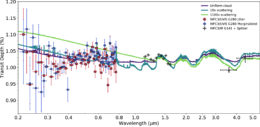What’s going on around the hot Jupiter exoplanet HAT-P-41b? This planet’s atmosphere is harboring a mystery, recently revealed by observations that span infrared through ultraviolet (UV) light.
Expanding the Spectrum

As a star’s light filters through a planet’s atmosphere on its way to Earth, the atmosphere absorbs certain wavelengths depending on its composition. [European Southern Observatory]
Ideally, we’d gather spectroscopic observations of planet transits across a broad range of wavelengths, because each region of the electromagnetic spectrum provides an additional constraint for atmospheric models. But so far we’ve probed fewer than 20 exoplanets in the UV, a regime that can reveal critical details of atmospheric physics.
In a new study, a team led by Nikole Lewis (Cornell University) adds one more planet to this collection, the hot Jupiter HAT-P-41b — but what these scientists found was unexpected.

HAT-P-41b’s transmission spectrum from 0.2 to 5.0 μm (red/blue/gray data points) plotted along with several atmospheric models (green, teal, and purple lines). [Lewis et al. 2020]
Unexpected Absorption
Lewis and collaborators conducted one of the most comprehensive explorations of an exoplanet atmosphere yet, combining high-precision Hubble and Spitzer observations to construct a transmission spectrum spanning UV through infrared wavelengths. They then use multiple different approaches to conduct detailed atmospheric modeling for HAT-P-41b from their observations.
The result? The authors show that HAT-P-41b can’t be neatly described by the models we usually fit to hot Jupiters. To fit the full range of observations, there must be a molecular species that readily absorbs near-UV light present in unexpectedly large quantities in this hot Jupiter’s atmosphere. Lewis and collaborators argue that the most likely candidate is H- (the hydrogen anion, or a hydrogen atom with an extra, easily-ejected electron), although other candidates include CrH, AlO, and VO.
A New Chemistry
What does this mean? Based on the temperature measured for HAT-P-41b (a toasty ~1,700 K), the chemistry we typically assume for hot Jupiter atmospheres falls several orders of magnitude short of producing enough H- to explain observations. Instead, the authors posit that there must be some new chemistry, not yet taken into account, that produces the excess H- abundance — possibly driven by the intense ultraviolet radiation from this planet’s F-type host star.
This striking discovery has broad implications. If correct, it likely means that other hot Jupiters also contain large amounts of H- (or an equivalent near-UV absorber) in their atmospheres. In turn, this would imply that our understanding of hot Jupiter atmospheres needs to be substantially reworked.If nothing else, the Lewis and collaborators’ results demonstrate the importance of broad-spectrum observations of planetary atmospheres, as well as the benefit of using multiple reduction and interpretation techniques to analyze the observations. This careful approach will become even more valuable with the upcoming launch of the James Webb Space Telescope and the new era of exoplanet atmosphere exploration it will usher in!
Citation
“Into the UV: The Atmosphere of the Hot Jupiter HAT-P-41b Revealed,” N. K. Lewis et al 2020 ApJL 902 L19. doi:10.3847/2041-8213/abb77f

